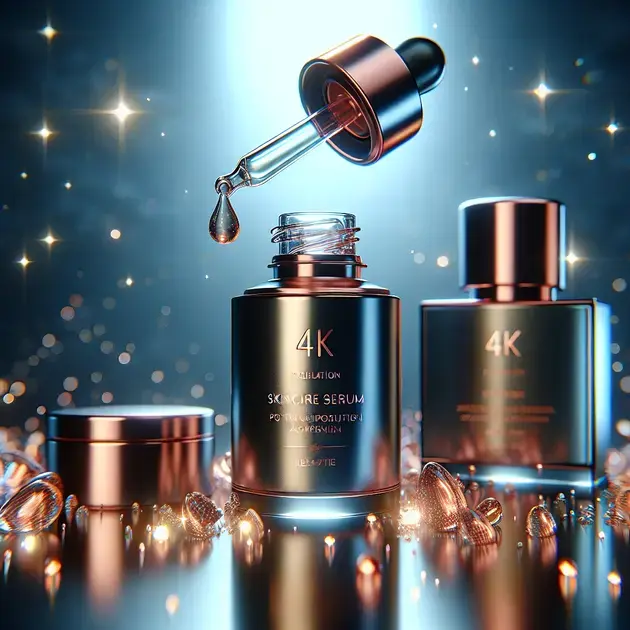Using serum for flawless skin has become a popular trend in skincare routines. With a wide range of serums available in the market, it can be overwhelming to choose the right one for your specific skin concerns.
Serums are lightweight, fast-absorbing liquids that contain high concentrations of active ingredients. They are designed to target specific skin issues such as hydration, brightening, or anti-aging. The key to achieving flawless skin lies in understanding your skin type and needs, and selecting a serum that addresses those concerns effectively.

Choosing the Right Serum for Your Skin Type
Choosing the right serum for your skin type is crucial to ensure that you are addressing your specific skincare needs effectively. To start, identify your skin type, whether it’s dry, oily, combination, or sensitive. Websites like wikiHow offer detailed guides on how to determine your skin type through simple tests you can do at home.
Once you’ve determined your skin type, research serums that are formulated to target your specific concerns. For example, if you have dry skin, look for serums containing hyaluronic acid to provide intense hydration. On the other hand, if you have oily skin, opt for serums with ingredients like niacinamide to control excess oil production.
Consider factors like your age and any skin issues you want to address, such as fine lines or acne. Websites like Byrdie offer comprehensive reviews and recommendations for serums tailored to different age groups and skin concerns.
Don’t forget to read reviews and testimonials from other users with similar skin types to see how the serum has worked for them. Platforms like Sephora allow customers to leave reviews and ratings for products, giving you valuable insights before making a purchase.
Lastly, consider consulting with a dermatologist or skincare specialist for personalized recommendations based on your skin type and concerns. Many clinics and spas offer virtual consultations, making it easier to get expert advice from the comfort of your home.
Maximizing the Benefits of Serum in Your Skincare Routine
To maximize the benefits of serum in your skincare routine, it’s essential to apply it correctly for optimal absorption and effectiveness. Start by cleansing your face with a gentle cleanser to remove any impurities and prepare your skin for the serum. Websites like Paula’s Choice provide detailed guides on the best practices for cleansing your skin.
Next, exfoliate your skin 2-3 times a week to remove dead skin cells and allow the serum to penetrate deeply into the skin. Platforms like Dermstore offer step-by-step tutorials on how to exfoliate your face effectively for a glowing complexion.
After exfoliation, apply a toner to balance the skin’s pH levels and prepare it for the serum. Toners containing ingredients like glycolic acid or witch hazel can help enhance the absorption of the serum. Websites like Cosmopolitan debunk common myths about toners and provide insights into the benefits of incorporating them into your routine.
When applying the serum, use gentle, upward motions to massage it into your skin and promote circulation. Allow the serum to fully absorb before layering moisturizer and sunscreen on top to lock in the benefits. Platforms like Allure offer recommendations for serums that work well with different types of moisturizers.
Consistency is key when using serums, so make sure to incorporate them into your daily skincare routine for long-term results. Tracking your progress and observing any changes in your skin can help you adjust your routine and choose the right serum for your evolving skincare needs.
Achieving Flawless Skin with the Perfect Serum
Achieving flawless skin with the perfect serum requires a holistic approach that includes not only the right serum but also a healthy lifestyle and skincare regimen. Start by staying hydrated and maintaining a balanced diet rich in antioxidants and essential nutrients to support skin health. Websites like Healthline explain the benefits of antioxidants for skin and overall well-being.
Incorporate regular exercise into your routine to improve blood circulation and promote a healthy glow from within. Platforms like Self offer at-home workout guides that cater to different fitness levels and goals.
Ensure you get an adequate amount of sleep each night to allow your skin time to repair and regenerate. Websites like Sleep Foundation provide insights into how sleep impacts skin health and offer tips for better sleep hygiene.
Protect your skin from harmful UV rays by applying sunscreen daily, even on overcast days. Look for serums with added SPF for an extra layer of protection against sun damage. Platforms like Byrdie recommend serums with built-in sun protection for convenience and efficacy.
Don’t forget to pamper your skin with regular facials and treatments to address specific concerns and maintain a radiant complexion. Visiting a reputed spa or skincare clinic for professional treatments can complement the benefits of your serum and enhance your overall skincare routine.

Avoiding Common Mistakes When Applying Serum Face
Applying serum to your face may seem like a simple step in your skincare routine, but there are common mistakes that many people make that can prevent you from getting the most out of this potent product. One common mistake is applying too much serum, thinking that more product will lead to better results. However, using too much serum can actually be counterproductive and may cause irritation or prevent the product from absorbing into your skin effectively.
To avoid this mistake, it’s important to read the instructions on the serum packaging and use the recommended amount for your face. Another common mistake is not properly cleansing and exfoliating your skin before applying serum. Dead skin cells and impurities can create a barrier that prevents the serum from penetrating deep into your skin.
Make sure to cleanse your face thoroughly before applying serum to ensure maximum absorption. Finally, another mistake to avoid is mixing different types of serums that may not be compatible with each other. Some ingredients in serums can react negatively when mixed with other products, leading to skin irritation or ineffectiveness.
Stick to using one serum at a time or consult with a skincare professional to create a safe and effective serum routine for your skin type.
Remember, applying serum correctly can help you achieve healthy and radiant skin.
Incorporating Serum into Your Morning and Night Routine
Incorporating serum into your morning and night routine can enhance the overall health and appearance of your skin. In the morning, applying serum before your moisturizer and sunscreen can provide a protective barrier against environmental pollutants and UV radiation. Choose a serum with antioxidants like vitamin C to boost skin protection and repair.
At night, applying serum before your night cream allows the active ingredients to work overnight to repair and rejuvenate your skin. Look for serums with ingredients like retinol or hyaluronic acid to target specific skin concerns such as wrinkles or hydration.
To incorporate serum effectively into your routine, start by cleansing your face and applying toner. Then, gently massage a pea-sized amount of serum onto your skin, focusing on areas of concern. Follow up with your moisturizer to lock in the serum’s benefits.
Consistency is key when incorporating serum into your routine, so make sure to apply it daily for best results. With regular use, you’ll notice improvements in your skin’s texture, tone, and overall radiance.
The Science Behind Serum Ingredients for Healthy Skin
Serums are packed with powerful ingredients that can provide numerous benefits to your skin. Understanding the science behind serum ingredients can help you choose the right product for your skincare concerns. One common ingredient found in serums is vitamin C, known for its antioxidant properties that can brighten and even out skin tone.
Another key ingredient is hyaluronic acid, which is a humectant that attracts and retains moisture in the skin, making it appear plump and hydrated. Peptides are also frequently found in serums, as they can stimulate collagen production and improve skin elasticity.
When selecting a serum, look for ingredients that target your specific skin concerns, whether it’s fine lines, hyperpigmentation, or dryness. It’s essential to choose a serum with a stable formulation to ensure the ingredients remain effective and potent.
By understanding the science behind serum ingredients, you can make informed decisions about which products will best suit your skin and enhance its overall health and appearance.
Conclusion
In conclusion, applying serum to your face requires attention to detail to avoid common mistakes that can hinder its effectiveness. By following the recommended amount, properly cleansing, and refraining from mixing incompatible products, you can maximize the benefits of serums and achieve healthy, radiant skin.
Incorporating serum into your daily skincare routine, both in the morning and at night, can significantly improve the overall health and appearance of your skin. By choosing serums with antioxidants and active ingredients tailored to your skin concerns, you create a protective barrier against environmental factors and promote skin repair and rejuvenation.
Understanding the science behind serum ingredients is crucial in selecting the right product to address specific skin issues effectively. Ingredients like vitamin C, hyaluronic acid, and peptides play key roles in enhancing skin texture, hydration, and elasticity. By making informed choices and ensuring stable formulations, you can optimize the benefits of serums for healthier and more vibrant skin.

















